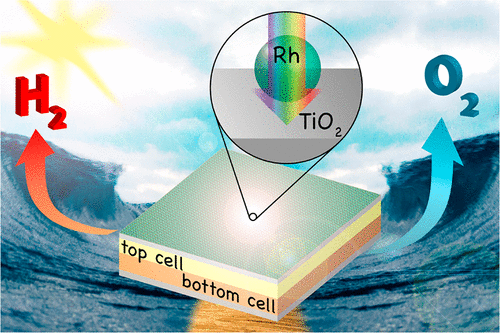当前位置:
X-MOL 学术
›
ACS Energy Lett.
›
论文详情
Our official English website, www.x-mol.net, welcomes your
feedback! (Note: you will need to create a separate account there.)
Monolithic Photoelectrochemical Device for Direct Water Splitting with 19% Efficiency
ACS Energy Letters ( IF 19.3 ) Pub Date : 2018-06-25 00:00:00 , DOI: 10.1021/acsenergylett.8b00920 Wen-Hui Cheng 1, 2 , Matthias H. Richter 2, 3 , Matthias M. May 4, 5, 6 , Jens Ohlmann 7 , David Lackner 7 , Frank Dimroth 7 , Thomas Hannappel 6 , Harry A. Atwater 1, 2 , Hans-Joachim Lewerenz 2, 8
ACS Energy Letters ( IF 19.3 ) Pub Date : 2018-06-25 00:00:00 , DOI: 10.1021/acsenergylett.8b00920 Wen-Hui Cheng 1, 2 , Matthias H. Richter 2, 3 , Matthias M. May 4, 5, 6 , Jens Ohlmann 7 , David Lackner 7 , Frank Dimroth 7 , Thomas Hannappel 6 , Harry A. Atwater 1, 2 , Hans-Joachim Lewerenz 2, 8
Affiliation

|
Efficient unassisted solar water splitting, a pathway to storable renewable energy in the form of chemical bonds, requires optimization of a photoelectrochemical device based on photovoltaic tandem heterojunctions. We report a monolithic photocathode device architecture that exhibits significantly reduced surface reflectivity, minimizing parasitic light absorption and reflection losses. A tailored multifunctional crystalline titania interphase layer acts as a corrosion protection layer, with favorable band alignment between the semiconductor conduction band and the energy level for water reduction, facilitating electron transport at the cathode–electrolyte interface. It also provides a favorable substrate for adhesion of high-activity Rh catalyst nanoparticles. Under simulated AM 1.5G irradiation, solar-to-hydrogen efficiencies of 19.3 and 18.5% are obtained in acidic and neutral electrolytes, respectively. The system reaches a value of 0.85 of the theoretical limit for photoelectrochemical water splitting for the energy gap combination employed in the tandem-junction photoelectrode structure.
中文翻译:

用于直接水分解的单片光电电化学装置,效率为19%
有效的无辅助太阳能水分解(一种以化学键的形式获取可储存的可再生能源的途径)需要优化基于光伏串联异质结的光电化学装置。我们报告了一种单片式光电阴极器件架构,该架构展现出显着降低的表面反射率,从而最大限度地减少了寄生光的吸收和反射损耗。量身定制的多功能结晶二氧化钛中间层起腐蚀保护层的作用,在半导体导带和能级之间具有良好的能带对准,可降低水分,从而促进电子在阴极-电解质界面处的传输。它还为高活性Rh催化剂纳米颗粒的粘附提供了良好的基质。在模拟的AM 1.5G辐射下,太阳到氢的效率分别为19.3和18。在酸性和中性电解液中分别获得5%。对于串联结光电极结构中使用的能隙组合,该系统达到光化学水分解的理论极限的0.85的值。
更新日期:2018-06-25
中文翻译:

用于直接水分解的单片光电电化学装置,效率为19%
有效的无辅助太阳能水分解(一种以化学键的形式获取可储存的可再生能源的途径)需要优化基于光伏串联异质结的光电化学装置。我们报告了一种单片式光电阴极器件架构,该架构展现出显着降低的表面反射率,从而最大限度地减少了寄生光的吸收和反射损耗。量身定制的多功能结晶二氧化钛中间层起腐蚀保护层的作用,在半导体导带和能级之间具有良好的能带对准,可降低水分,从而促进电子在阴极-电解质界面处的传输。它还为高活性Rh催化剂纳米颗粒的粘附提供了良好的基质。在模拟的AM 1.5G辐射下,太阳到氢的效率分别为19.3和18。在酸性和中性电解液中分别获得5%。对于串联结光电极结构中使用的能隙组合,该系统达到光化学水分解的理论极限的0.85的值。











































 京公网安备 11010802027423号
京公网安备 11010802027423号